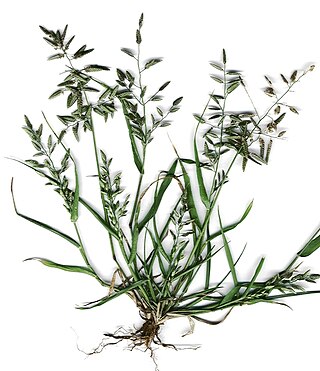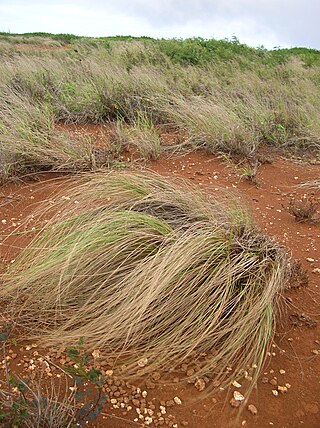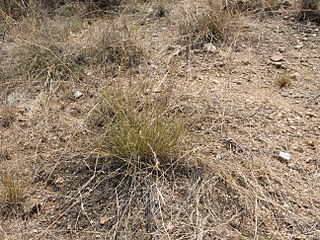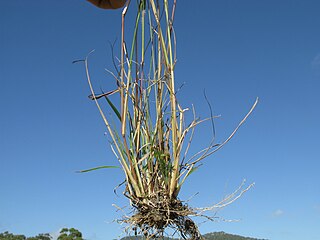
Eragrostis tef, also known as teff, Williams lovegrass or annual bunch grass, is an annual grass, a species of lovegrass native to the Horn of Africa, notably to both Eritrea and Ethiopia. It is cultivated for its edible seeds, also known as teff. Teff was one of the earliest plants domesticated. It is one of the most important staple crops in Ethiopia and Eritrea.

Eragrostis is a large and widespread genus of plants in the grass family, found in many countries on all inhabited continents and many islands.

Dactylis is a genus of Eurasian and North African plants in the bluegrass subfamily within the grass family. Dactylis is native to North Africa, they are found throughout the world, and are an invasive species. They are known in English as cock's-foot or cocksfoot grasses, also sometimes as orchard grasses.

Sporobolus is a nearly cosmopolitan genus of plants in the grass family. The name Sporobolus means "seed-thrower", and is derived from Ancient Greek word σπόρος (spóros), meaning "seed", and the root of βάλλειν (bállein) "to throw", referring to the dispersion of seeds. Members of the genus are usually called dropseeds or sacaton grasses. They are typical prairie and savanna plants, occurring in other types of open habitat in warmer climates. At least one species is threatened with extinction, and another is extinct.

Cyperus eragrostis is a species of sedge known by several common names, including tall flatsedge, nutgrass, tall nutgrass, umbrella sedge, chufa, Earth almond, zula nuts, edible galingale and pale galingale.

Glyceria is a widespread genus of grass family common across Eurasia, Australia, North Africa, and the Americas.

Eragrostis pectinacea is a species of grass known by the common name tufted lovegrass. This plant is native to the Americas from Canada to Argentina. It is widespread, growing in most open spaces at varying elevations and habitats, including in disturbed areas and roadsides.

Glyceria leptostachya is a species of mannagrass known by the common names davy mannagrass and narrow mannagrass.

Eragrostis dielsii, commonly known as mallee lovegrass, is a species of grass in the family Poaceae that is endemic to Australia.
Acrachne is a genus of Asian, African, and Australian plants in the grass family. Species in the genus are commonly known as goosegrass.
Airopsis is a genus of southern European and northern African plants in the grass family.
Eragrostis fosbergii is a rare species of grass known by the common name Fosberg's love grass. It is endemic to Hawaii, where it is known only from the Waianae Mountains on the island of Oahu. It was federally listed as an endangered species in 1996.

Lespedeza leptostachya is a rare species of flowering plant in the legume family known by the common names prairie lespedeza and prairie bush-clover. It occurs in the Upper Midwest region of the United States. The flowers are creamy-white to purplish and arranged into a narrow terminal spikes.

Eragrostis curvula is a species of grass known by the common name weeping lovegrass. Other common names include Boer lovegrass, curved lovegrass, Catalina lovegrass, and African lovegrass.

Eragrostis lehmanniana is a species of grass known by the common name Lehmann lovegrass. It is native to southern Africa. It is present elsewhere as an introduced species. It is well known as an invasive weed in some areas, such as Arizona in the United States.

Eragrostis pilosa is a species of grass in the family Poaceae. It is native to Eurasia and Africa. It may or may not be native to North America. It is widely introduced, and it is a common weed in many areas.

Eragrostis australasica, commonly known as swamp canegrass, is a tussock grass, in the subfamily Chloridoideae of the family Poaceae, that is endemic to Australia. It is a tufted perennial with strongly branched, cane-like culms, that grows up to 2.4 m in height. It is typically found on periodically flooded land in arid and semi-arid regions.

Eragrostis brownii is a widespread species of grass known as Browns lovegrass. Found in Australia and New Zealand, it may be seen growing in woodland or pasture. The grass may grow up to .6 m tall. The specific epithet brownii is named in honour of the Scottish botanist Robert Brown.

Eragrostis parviflora is a widespread species of grass known as weeping lovegrass. Growing to 1.3 m metres tall, it may be found in many parts of Australia and New Caledonia. Leaves are strongly ribbed, hairless or with marginal hairs; the leaf blade may be flat or inrolled.
















